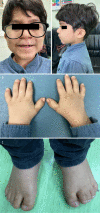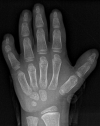Weill-Marchesani Syndrome, a Rare Presentation of Severe Short Stature with Review of the Literature
- PMID: 34057920
- PMCID: PMC8175056
- DOI: 10.12659/AJCR.930824
Weill-Marchesani Syndrome, a Rare Presentation of Severe Short Stature with Review of the Literature
Abstract
BACKGROUND Short stature is the second most common reason for referral to a pediatric endocrinology clinic. Numerous genetic causes have been identified. Weill-Marchesani syndrome (WMS) is one of the rare genetic disorders that cause short stature. It is caused by homozygous mutations in the FBN1 gene, ADAMTS10 gene, ADAMTS17 gene, or LTBP2 gene. Despite genetic heterogeneity, WMS is clinically homogeneous. It is characterized by short stature, brachydactyly, joint stiffness, ocular abnormalities, mainly microspherophakia and glaucoma, and occasionally cardiac defects. CASE REPORT A 9-year-old boy had bilateral narrow-angle glaucoma with lens subluxation, elevated intraocular pressure, and severe myopia since early childhood. He had phenotypic dysmorphic features and radiological findings consistent with WMS. He underwent lensectomy and scleral-fixated intraocular lens implantation as well as drug treatment to control the intraocular pressure. He was a slow grower, and his growth parameters showed disproportionate short stature with brachydactyly and joint stiffness. Growth hormone provocation tests were subnormal with a peak value of 7.89 ng/mL. CONCLUSIONS The constellation of clinical presentation, radiological findings, and the molecular examination confirmed a homozygous familial variant of the ADAMTS10 gene identified by carrier gene testing. This known familial variant creates a premature termination codon classified as a likely pathogenic cause of WMS. In this syndrome, glaucoma treatment is considered the greatest challenge. The disease-causing mechanism in WMS is not known but thought to be due to abnormal actin distribution and organization in fibroblasts as a result of impaired connections between extracellular matrix components and the cytoskeleton.
Conflict of interest statement
None.
Figures




Similar articles
-
Characteristics and genotype-phenotype correlations in ADAMTS17 mutation-related Weill-Marchesani syndrome.Exp Eye Res. 2023 Sep;234:109606. doi: 10.1016/j.exer.2023.109606. Epub 2023 Jul 26. Exp Eye Res. 2023. PMID: 37506754
-
A novel nonsense mutation in ADAMTS17 caused autosomal recessive inheritance Weill-Marchesani syndrome from a Chinese family.J Hum Genet. 2019 Jul;64(7):681-687. doi: 10.1038/s10038-019-0608-2. Epub 2019 Apr 25. J Hum Genet. 2019. PMID: 31019231
-
Geleophysic dysplasia and Weill-Marchesani syndrome: ADAMTSL2 a possible common gene.Ophthalmic Genet. 2024 Oct;45(5):499-505. doi: 10.1080/13816810.2024.2358973. Epub 2024 Jul 24. Ophthalmic Genet. 2024. PMID: 39044700
-
Weill-Marchesani syndrome with advanced glaucoma and corneal endothelial dysfunction: a case report and literature review.BMC Ophthalmol. 2015 Jan 9;15:3. doi: 10.1186/1471-2415-15-3. BMC Ophthalmol. 2015. PMID: 25571963 Free PMC article. Review.
-
Clinical homogeneity and genetic heterogeneity in Weill-Marchesani syndrome.Am J Med Genet A. 2003 Dec 1;123A(2):204-7. doi: 10.1002/ajmg.a.20289. Am J Med Genet A. 2003. PMID: 14598350 Review.
Cited by
-
Secondary Angle Closure Glaucoma in Weill-Marchesani Syndrome.Diagnostics (Basel). 2024 Oct 16;14(20):2303. doi: 10.3390/diagnostics14202303. Diagnostics (Basel). 2024. PMID: 39451626 Free PMC article.
-
A Novel Missense Mutation in the TGF-β-binding Protein-Like Domain 3 of FBN1 Causes Weill-Marchesani Syndrome with Intellectual Disability.Adv Biomed Res. 2023 Apr 28;12:114. doi: 10.4103/abr.abr_138_22. eCollection 2023. Adv Biomed Res. 2023. PMID: 37288014 Free PMC article.
-
Multi-organ phenotypes in mice lacking latent TGFβ binding protein 2 (LTBP2).Dev Dyn. 2024 Feb;253(2):233-254. doi: 10.1002/dvdy.651. Epub 2023 Sep 9. Dev Dyn. 2024. PMID: 37688792 Free PMC article. Review.
-
Microspherophakic Angle Closure Glaucoma in a Patient with Coffin-Siris Syndrome: Case Report.Appl Clin Genet. 2023 Aug 29;16:165-170. doi: 10.2147/TACG.S422312. eCollection 2023. Appl Clin Genet. 2023. PMID: 37663124 Free PMC article.
-
The extracellular matrix glycoprotein fibrillin-1 in health and disease.Front Cell Dev Biol. 2024 Jan 10;11:1302285. doi: 10.3389/fcell.2023.1302285. eCollection 2023. Front Cell Dev Biol. 2024. PMID: 38269088 Free PMC article. Review.
References
-
- Anil Bhansali AA, Parthan G, Gogate Y. Disorders of growth and development: Diagnosis and treatment. In: Anil Bhansali AA, Parthan G, Gogate Y, editors. Clinical Rounds in Endocrinology – Volume II – Pediatric Endocrinology. India: Springer, India; 2016. pp. 45–70.
-
- Turan S, Bereket A, Omar A, et al. Upper segment/lower segment ratio and armspan-height difference in healthy Turkish children. Acta Paediatr. 2005;94(4):407–13. - PubMed
-
- Jorge AAL, Grimberg A, Dattani MT, Baron J. Section III: Childhood and adolescent endocrinology; Chapter 11: Disdorders of Chidhood Growth. In: Sperling M, editor. Sperling Pediatric Endocrinology. 5th ed. Philadelphia: Elsevier; 2020. pp. 299–356.
Publication types
MeSH terms
Substances
LinkOut - more resources
Full Text Sources
Medical
Miscellaneous

